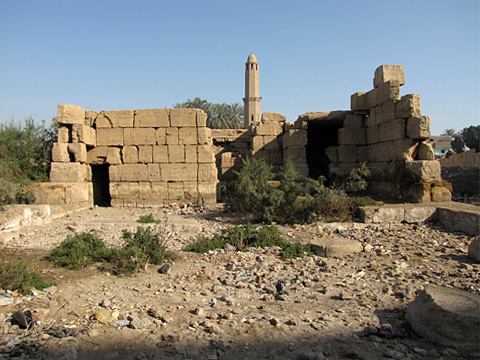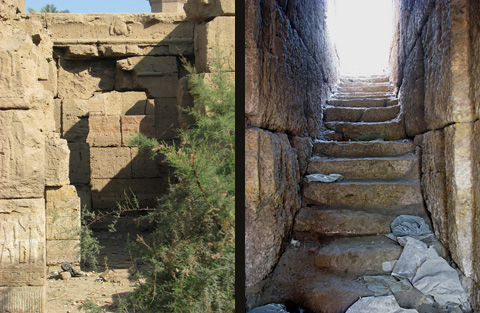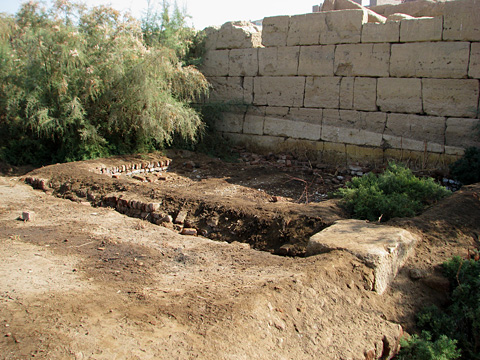https://egyptsites.wordpress.com/2010/09/07/the-temple-of-isis-at-shenhur/
Egyptian Monuments

The Temple of Isis at Shenhur
Once an important village on the east bank of the Nile, 20km north of Luxor, Shenhur is a little-visited site just to the south of the town of Qus. The Arabic name of the village is derived from hieroglyphs found on the Roman Temple of Isis at Shenhur, p3-š-n-hr which translates as 'The Lake of Horus', a mysterious name as there is no evidence of a lake or water feature here. The ruined temple lies behind a Mamaluke mosque and a sheikh's tomb.

Very few early travellers visited Shenhur. The site was first mentioned by John Gardner Wilkinson in his 'Topography of Thebes' published in 1835. The French artist Nestor L'Hôte visited Shenhur in 1839, making invaluable drawings of some of the reliefs and inscriptions which have since vanished, especially the eastern exterior walls of the temple decorated by Augustus, that now consist of only the lower courses of blocks. The German expeditionary Karl Lepsius visited and documented parts of the temple in 1845, but it never drew a great deal of serious interest until a Belgian-French archaeological mission began a decade of excavations there in 1992 under the direction of the late Jan Quaegebeur, Claude Traunecker and in later years, Harco Willems.

The temple has suffered a great deal of damage over the centuries by both stone-robbing and lime-burning. The walls of the structure were built from different qualities of limestone and the best of this was taken, leaving the poorer quality stone with few badly preserved reliefs in the northern part. The earliest (northern) part was built by the Emperor Augustus and this contains a central sanctuary, vestibule and door jambs that were decorated by Augustus.

A corridor around the sanctuary led to several side-chambers and one of the most interesting areas is part of an astronomical ceiling in the wabet, a small chamber dedicated to the New Year rituals, which the excavators have re-erected. The half of the astronomical ceiling now in place depicts the arms and legs of the goddess Nut, signs of the zodiac and some cosmic deities. The wabet was decorated during the reign of Caligula.

In the vestibule of the Augustan temple, large sandstone slabs of the original pavement were found to be still in position below remains of domestic structures of Byzantine date, including two granaries. During the clearance of a small chamber on the back inner wall of the Augustan temple, the excavators found a doorway with a bronze hinge still in place. Behind the doorway two secret rooms were built into the thickness of the wall. On both sides, a movable block could be rolled on small wheels which revealed an opening to steps down into the crypt.

In a second building phase during the reign of the Emperor Tiberius, a small possibly free-standing, chapel dedicated to the child-god Horudja was constructed to the south-west of the Augustan temple which is thought to have taken the rôle of the mammisi, or birth-house, common in Ptolemaic and Roman period temples. Only a few lower courses of blocks remain of this structure. Horudja at Shenhur is associated with the relatively obscure god Tutu. Here Tutu, was named as a son of the goddess Neith and can be seen in evidence in several monuments around the Coptos area and associated with several different gods.

Tutu at one time was acclaimed as a vanquisher of Apothis, who was the traditional enemy of the sun and cosmic order in Egypt. Tutu also became known as the chief of mythical demons, the destructive forces of Sekhmet and he was one of the gods, along with Bes and Horus who was able to harness these forces. Gradually, a cult grew up around the deity and he appeared on amulets, coins and in temple reliefs, often as a sphinx surrounded by Sekhmet's demons. By Roman times Tutu had become a fully-fledged deity depicted in human form, sometimes, as at Shenhur, the consort of Isis of Shenhur because he represented a local form of Horus. He is thought to have delivered spoken oracles here where he is named as 'The Powerful and Victorious God' and is depicted surrounded by various goddesses. Min is also very much in evidence at Shenhur, as in other parts of the Coptos region. A variety of rituals are depicted on the walls, some of them unidentified and reliefs include a whole range of Theban deities.

In front of the Augustan temple a small hypostyle hall was built which contained four columns, but only two bases now remain. The western wall of this structure connected the chapel of Horudja to the main part of the temple. Fragments of a cartouche of the Roman Emperor Nero were found inside the hypostyle hall and this is the currently proposed date of the structure.

The last building phase of the temple consisted of adding a large pronaos, on a transverse axis which forms the cross-bar of the T-shaped plan and gives the temple a sense of unity. This hall originally contained 16 columns but very little of this later phase of the temple now remains, due to the fact that it was built with the better quality limestone which has now been taken away or burnt. The pronaos was left unfinished and uninscribed, so it is uncertain who built it.

The eastern and western exterior walls of the Augustan temple were decorated by the Emperor Claudius. The remains of the western exterior wall are quite well-preserved and show some good reliefs, due to being covered by earth and so escaping the ravages of the rest of the temple. The decoration contains many often mysterious rituals involving uncertain deities, but those that can be identified include Tutu, Neith, Mut, Min and Amun. Several domestic mudbrick and fired brick structures from various periods were found to have been built against the western temple wall.

The exterior north wall, decorated by Tiberius, is also interesting and includes a double-scene depicting the Emperor in front of the Theban Triad and the Coptos Triad. There is a false door in the centre of the rear wall. Excavations revealed that a structure of some sort had been built over the false door and column bases still remain. Between the column bases three limestone basins were found, including a model of a rectangular sacred lake with steps leading from each side. A later occupation level was found here consisting of domestic buildings dating from the 5th Century.
How to get there
Shenhur is situated between Luxor and Qift on the main road one would take if driving to Dendera. The road follows a canal and 6 km before the town of Qus, a sign pointing left to Shenhur takes you across a bridge and into the village. A track winds through the village towards the Mamaluke mosque. Unfortunately the temple is not currently open to visitors without permission from the SCA.
-- Sent from my Linux system.
No comments:
Post a Comment